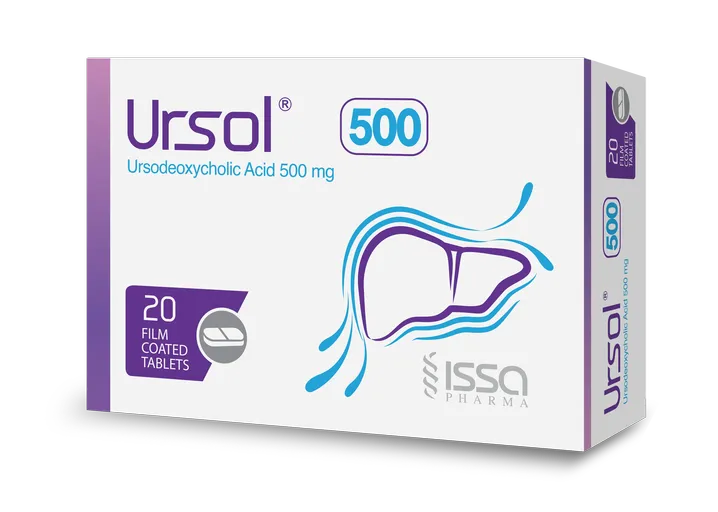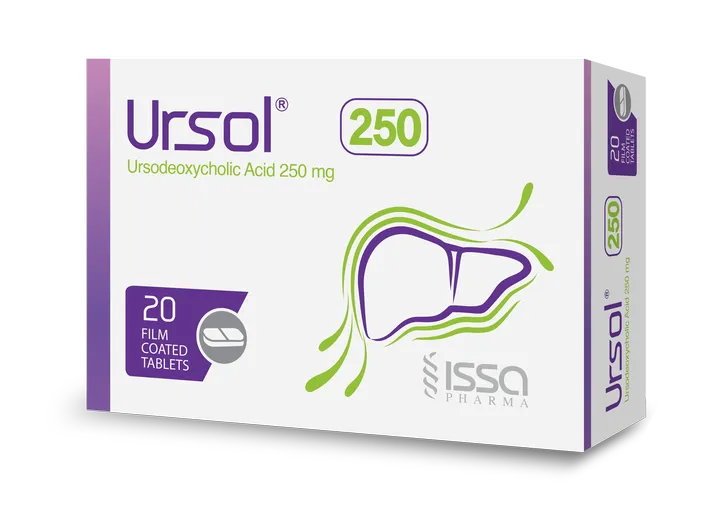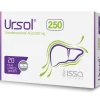COMPOSITION AND EXCIPIENTS
Active ingredient:
Each film coated tablet of Ursol 250 contains Ursodeoxycholic Acid 250 mg.
Each film coated tablet of Ursol 500 contains Ursodeoxycholic Acid 500 mg.
Excipients:
Magnesium stearate, Polysorbate 80, Povidone, microcrystalline cellulose, colloidal anhydrous silica, Crospovidone,
Talc, Hypromellose, Macrogol, Iron oxide yellow (For Ursol 500 mg).
PHARMACODYNAMIC PROPERTIES
UDCA is a bile acid which effects a reduction in cholesterol in biliary fluid primarily by dispersing the cholesterol and forming a liquid-crystal phase.
When given by mouth, ursodeoxycholic acid reduces the ratio of cholesterol to bile salts plus phospholipids in bile, causing desaturation of cholesterol saturated bile.
Cystic fibrosis – Paediatric population: treatment with UDCA can decrease bile duct proliferation, halt progression of histological damage and even reverse hepatobiliary changes if given at early stage of cystic fibrosis associated hepatobiliary disorders CFAHD.
PHARMACOKINETIC PROPERTIES
UDCA occurs naturally in the body. When given orally it is rapidly and completely absorbed. It is 96-98% bound to plasma proteins and efficiently extracted by the liver and excreted in the bile as glycine and taurine conjugates. In the intestine some of the conjugates are deconjugated and reabsorbed. The conjugates may also be dehydroxylated to lithocholic acid, part of which is absorbed, sulphated by the liver and excreted via the biliary tract.
INDICATIONS
It is indicated in the treatment of primary biliary cirrhosis (PBC) and for the dissolution of radiolucent ,cholesterol-rich gall-stones in patients with a functioning gall bladder. Cholesterol stones coated with calcium or stones composed of bile pigments are not dissolved by ursodeoxycholic acid.
Paediatric population: Hepatobiliary disorders associated with cystic fibrosis in children aged 6 to 18 years.
CONTRAINDICATIONS
Ursodeoxycholic acid should not be used in patients with:
radio-opaque calcified gall-stones.
Acute inflammation of the gall bladder or biliary tract.
occlusion of the biliary tract.
frequent episodes of biliary colic.
impaired contractility of the gall bladder.
hypersensitivity to bile acids or any excipient of the formulation When used in hepatobiliary disorders associated with cystic fibrosis in children aged 6 to 18 years.
who are pregnant or breastfeeding, or in women who may become pregnant.
chronic liver disease, peptic ulcers or in those with inflammatory diseases of the small intestine and colon.
Paediatric population: Unsuccessful portoenterostomy or without recovery of good bile flow in children with biliary atresia.
WARNINGS
The tablets should be taken under medical supervision.
During the first 3 months of treatment, liver function parameters AST (SGOT), ALT (SGPT) and γ-GT should be monitored by the physician every 4 weeks, thereafter every 3 months.
When used for treatment of advanced stage of primary biliary cirrhosis: In very rare cases decompensation of hepatic cirrhosis has been observed, which partially regressed after the treatment was discontinued.
In patients with PBC, in rare cases the clinical symptoms may worsen at the beginning of treatment, e.g. the itching may increase. In this case the dose should be reduced to 250 mg daily and then gradually increased to the recommended dose described.
If diarrhoea occurs, the dose must be reduced and in cases of persistent diarrhoea, the therapy should be discontinued.
When used for dissolution of cholesterol gallstones: In order to assess therapeutic progress and for timely detection of any calcification of the gallstones, depending on stone size, the gall bladder should be visualised (oral cholecystography) with overview and occlusion views in standing and supine positions (ultrasound control) 6-10 months after the beginning of treatment.
If the gall bladder cannot be visualised on X-ray images, or in cases of calcified gallstones, impaired contractility of the gall bladder or frequent episodes of biliary colic, UDCA should not be used.
Female patients taking UDCA for dissolution of gallstones should use an effective non-hormonal method of contraception, since hormonal contraceptives may increase biliary lithiasis.
pregnancy and lactation:
Pregnancy: There are limited data from the use of UDCA in pregnant women. It must not be used during pregnancy unless clearly necessary. The possibility of a pregnancy must be excluded before beginning treatment.
Breastfeeding: According to few documented cases of breastfeeding women, milk levels of UDCA are very low and probably no adverse reactions are to be expected in breastfed infants.
DRUG INTERACTIONS
The tablets should not be administered concomitantly with charcoal, colestyramine, colestipol or antacids containing aluminium hydroxide and/or aluminium oxide, because these preparations bind UDCA in the intestine and thereby inhibit its absorption and efficacy.
The tablets can affect the absorption of ciclosporin from the intestine.
In isolated cases the tablets can reduce the absorption of ciprofloxacin.
In a clinical study in healthy volunteers concomitant use of UDCA and rosuvastatin resulted in slightly elevated plasma levels of rosuvastatin.
UDCA has been shown to reduce the plasma peak concentrations (Cmax) and the area under the curve (AUC) of the calcium antagonist nitrendipine in healthy volunteers.
Oral contraceptives ,estrogenic hormones and blood cholesterol lowering agents such as clofibrate increase hepatic cholesterol secretion and may therefore encourage biliary lithiasis, which is a counter-effect to ursodeoxycholic acid used for dissolution of gallstones.
UNDESIRABLE EFFECTS
Hepatobiliary disorders: During treatment with UDCA, calcification of gallstones can occur in very rare cases.
During therapy of the advanced stages of PBC, in very rare cases decompensation of hepatic cirrhosis has been observed, which partially regressed after the treatment was discontinued.
Gastrointestinal disorders: In clinical trials, reports of pasty stools or diarrhoea during UDCA therapy were common.
Very rarely, severe right upper abdominal pain has occurred during the treatment of primary biliary cirrhosis (PBC).Ursodeoxycholic acid may give rise to nausea and vomiting.
Skin and subcutaneous tissue disorders: Very rarely, urticaria can occur. Ursodeoxycholic acid may give rise to pruritus.
POSOLOGY AND METHOD OF ADMINISTRATION
For primary biliary cirrhosis (PBC):
The daily dose depends on body weight, and ranges from 3 to 7 tablets (10 – 15 mg ursodeoxycholic acid per kg per day in two to four divided doses). For the first 3 months of treatment, ursodeoxycholic acid tablets should be taken divided over the day. With improvement of the liver values the daily dose may be taken once daily in the evening.
Body weight (kg) | Daily dose (mg/kg) | first 3 months | subsequently | ||
morning | midday | evening | Evening (1× daily) | ||
47 – 62 | 12 – 16 | 1 | 1 | 1 | 3 |
63 – 78 | 13 – 16 | 1 | 1 | 2 | 4 |
79 – 93 | 13 – 16 | 1 | 2 | 2 | 5 |
94 – 109 | 14 – 16 | 2 | 2 | 2 | 6 |
Over 110 | 2 | 2 | 3 | 7 | |
Dissolution of Gallstones:
Adults: The usual dose is 8–12 mg/kg/day to be taken in the evening.
The time required for dissolution of gallstones is likely to range from 6 to 24 months depending on stone size and composition.
Follow-up cholecystograms or ultrasound investigation may be useful at 6 month intervals until the gallstones have disappeared.
Paediatric population:
Children with cystic fibrosis aged 6 year to less than 18 years: 20 mg/kg/day in 2-3 divided doses, with further increase to 30 mg/kg/day if necessary.
Cholesterol rich gallstones and PBC are very rare in children but when they occur, dosage should be related to bodyweight. There are no adequate data on the efficacy and safety in this population.
Evening | Mid-day | Morning | Daily dose [mg/kg BW] | Body weight [kg] |
1 | — | 1 | 17-25 | 20 – 29 |
1 | 1 | 1 | 19-25 | 30 – 39 |
2 | 1 | 1 | 20-25 | 40 – 49 |
2 | 2 | 1 | 21-25 | 50 – 59 |
2 | 2 | 2 | 22-25 | 60 – 69 |
3 | 2 | 2 | 22-25 | 70 – 79 |
3 | 3 | 2 | 22-25 | 80 – 89 |
3 | 3 | 3 | 23-25 | 90 – 99 |
4 | 3 | 3 | 23-25 | 100 – 109 |
4 | 4 | 3 | >110 |
OVERDOSE
Diarrhoea may occur in cases of overdose. In general, other symptoms of overdose are unlikely because the absorption of UDCA decreases with increasing dose and therefore more is excreted with the faeces.
The consequences of diarrhoea should be treated symptomatically with restoration of fluid and electrolyte balance.
STORAGE CONDITIONS
Store at temperature below 25 °C.
PACKAGING
Ursol (250 – 500) mg is supplied as blister strips (Aluminum – White P.V.D.C),each strip contains 10 F.C. Tablets and each pack contains 2 or 5 strips with enclosed leaflet ( 20 or 50 F.C. Tablets per pack).



